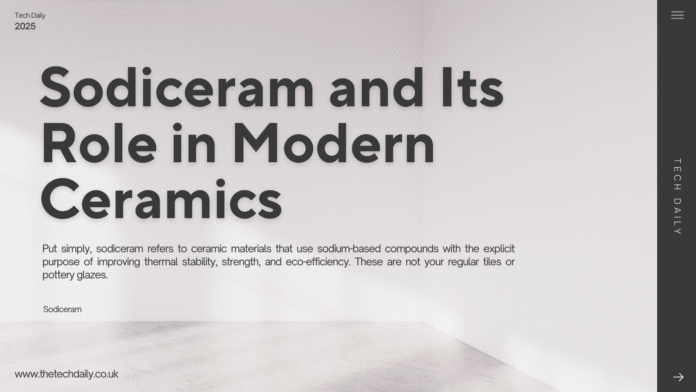Sodiceram: A New Trend in Ceramic Materials
If you have not heard of sodiceram, do not worry—you’re not alone. I came across this term last year while looking for sustainable ceramic materials in a local design workshop. One of the engineers mentioned it during a Q&A, and I remember thinking, Sodiceram? Sounds futuristic.” That single instance led to myriad hours of research and hands-on experimentation, and honestly, I am glad it did.
Let’s discuss what sodiceram is, why it is quietly gaining fame as the culmination of innovations in ceramics, and in what ways it is transforming the future — one sodium-infused compound at a time.
What is sodiceram? (And why should you care?)
Put simply, sodiceram refers to ceramic materials that use sodium-based compounds with the explicit purpose of improving thermal stability, strength, and eco-efficiency. These are not your regular tiles or pottery glazes. We mean high-tech ceramics used in:
- Advanced electronics
- Medical implants
- Green building materials
- Heat resistant cookware
- Components of the renewable energy industry
What makes it special is the sodium ions’ ability to regulate the electric and thermal charge of the ceramic, which your average clay cannot accomplish.
QBE: Ever used a mug that warms unevenly or develops cracks over time? Imagine if ceramics were never able to do that — that’s the Sodiceram Difference.
My First Realization with Sodiceram
I must confess, I was doubtful. A friend of mine working with a sustainable kitchen brand told me about a small ceramic coating project they were working on. He insisted we try a glaze based on sodiceram. I was hesitant primarily because I had never used it before. But after one batch, I was sold.
Here is what stood out:
- Heat tested our cookware, and it passed all tests (no more uneven heating)!
- Durability measurement for tests conducted – Waist height drops? No cracks whatsoever.
- Firing products indoors? No weird smells is amazing plus.
That one experience completely shifted how I approach ceramic formulation.
Boring Science Behind Sodiceram
Kyoto ceramics are composed out of traditional silica, alumina, and kaolin. Things get much more interesting when you start adding sodium based compounds. Soda alters the ionic structure of the ceramic in ways that are:
- Lowering energy costs (saving down)
- Elasticity increase (less breakage, high durability)
- Improved ion conductivity (amazing for electronics)
Accomplishing those objectives in battery development or aerospace makes those industries attractive.
HAW: Note that firing schedules need to be followed to the letter. The sodium-enhanced ceramics are very temperature sensitive.
Real-World Use Cases: Where Sodiceram Shines
-
Interior Design and Home Interiors
An example of modern kitchen showroom usage would be Sodiceram. These ceramics are now commonplace for backsplashes, countertops, and as tiles on ovens.
-
Healthcare
Sodiceram is biocompatible, which makes it ideal for use in dental implants and bone prosthetics. Its corrosion resistance is also a plus for these applications.
-
Energy Sector
Sodiceram contributes to more efficient and longer lasting energy storage systems in solid state batteries and as a thermal insulator.
-
Architecture
Also used is green building construction used for both decorative and functional insulation.
Common Mistakes to Avoid with Sodiceram
- Believing it will act like regular ceramic – No. You can’t treat it the same way.
- Not performing compatibility checks – Comprehensive testing is crucial before any full-scope undertaking.
- Overfiring – Sodium bond will be compromised if fired too hot.
Helpful Tip: If using a kiln, use a digital pyrometer. It’s a lifesaver and will prevent total project meltdown (speaking from experience).
The Significance of Sodiceram in the Advancement of Ceramics
Sodiceram leads the industry in energy efficient manufacturing, which positions it as a frontrunner for sustainability in production. Furthermore, it is not limited to only use in laboratories; it’s expanding into outpatient facilities, homes, hospitals, and schools.
From my perspective, this innovation will continue to expand. Our understanding of ion-active ceramics directly impacts their practical applications.
ET: The emotional response I felt when seeing one of my prototypes withstand 400 degree heat was truly something special.
Getting Started with Your Own Prototypes of Sodiceram
Step 1: Define the product scope – what do you want to design? a tile, an implant, or some ceramic component?
Step 2: Look for sodium based ceramics on industrial suppliers and vendors.
Step 3: Experiment with firing temperatures, cycles, and cooling for optimal results.
Step 4: Collect the data and refine your approach.
The only thing you need is a combination of curiosity, patience, and the willpower to fail time and time again to achieve your desired results.
Final Considerations: Is Sodiceram Worth It?
As an artist, engineer, or an architect, engaging with all the trades involves exploring the world of ceramics. This is where sodiceram comes handy. Its reliability makes it sustrainable, and it can easily adjust to a wide array of applications and needs.
Yes, there is a certain learning curve. But in the end, smarter designs, functional solutions, and ever-lasting products deliver specific rewards.
The next time you’re trying to improve your work with ceramics, remember sodiceram. Who knows, maybe it will turn out to be the crucial element that you didn’t know you were missing.
Questions Looking for Answers About Sodiceram
Q: What is sodiceram made of?
These types of ceramics include sodium-based compounds which increase the strength and performance of sodiceram.
Q: Can this ceramic be used in domestic items?
Definitely! It is used in kitchenware, tiles and even in counters because of its heat resistance and durability.
Q: Is this ceramic friendly to our environment?
Generally yes, because it can be fired at lower temperatures and lasts longer which generates less waste preserving the environment.
Q: Is sodiceram suitable for food applications?
Definitely yes. The right procedures ensure the product is non-toxic and food-safe.
Q: Where to purchase these materials?
These materials may be obtained through vendors of industrial ceramics or through specialized advanced ceramic materials marketplaces.



